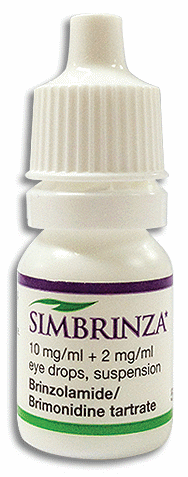Simbrinza (generic name: brinzolamide and brimonidine tartrate) can be prescribed to treat high pressure inside the eye, which may happen in conditions like open-angle glaucoma or ocular hypertension. These conditions can lead to damage in the optic nerve if not properly controlled, and this damage can cause vision loss over time.
This medicine combines two active ingredients that work together to reduce pressure in the eye. The first, brinzolamide, helps lower pressure by reducing the amount of fluid made inside the eye. The second, brimonidine tartrate, also helps by both lowering fluid production and helping fluid drain out more easily. This combined action makes Simbrinza useful for people who need more pressure reduction than one medicine can provide on its own.
Simbrinza belongs to a class of medicines called ophthalmic eye drops, and it is applied directly to the eye. It is meant for adults and is not usually recommended for children under 18. A healthcare provider may recommend Simbrinza when other single treatments are not effective enough on their own.
Dosage
It is important to follow the dosage instructions printed on the label of the box. Check with a doctor or pharmacist if there are any doubts regarding the proper dosage and treatment regimen.
The usual dose is 1 drop in the affected eye(s), twice a day, at evenly spaced times. This medicine is for eye use only—do not swallow or inject it.
How to use the drops:
-
Shake the bottle well before each use.
-
Wash hands and tilt the head back.
-
Pull down the lower eyelid to form a small pocket.
-
Hold the bottle above the eye and squeeze out one drop.
-
Close the eye gently and press the inner corner for 1–2 minutes.
-
Wait at least 5 minutes before using any other eye drops.
If a dose is missed, and it’s almost time for the next dose, skip the missed one. Do not apply two drops to make up for a missed dose.
Note: The eye drop is usually white or off-white and must be shaken well before use.
Storage
Simbrinza should be stored in a safe, dry place away from direct sunlight and heat. Keep the bottle tightly closed when not in use.
-
Store below 25 °C (77 °F).
-
Do not freeze.
-
Protect from moisture and light.
-
After opening, discard the bottle 4 weeks later, even if some solution remains.
-
Do not use after the expiry date. This is usually the last day of the month shown on the package.
This text is for informational purposes only. Please consult a doctor or pharmacist before using any medication.
The information leaflet that comes with the medication includes full information about the correct usage, storage, and possible side effects. Be sure to read and understand these, and if there are any questions, discuss these with a healthcare provider or pharmacist before starting treatment.
Pregnancy/Breastfeeding
Pregnant women should not be using Simbrinza unless this has been discussed with a healthcare provider, as it might harm the unborn baby or pose a risk of miscarriage. For this reason, women planning to become pregnant should use appropriate birth control measures during the treatment and one month after taking the last dose of Simbrinza.
Simbrinza may pass into breast milk, and mothers should consult with a doctor if already feeding or planning to feed an infant.
Most people who use Simbrinza do not experience any adverse side effects. Doctors prescribe this medication because they assess that the benefits of treatment outweigh any likely unwanted effects.
Some of the side effects that have been reported include:
-
Blurred vision
-
Eye redness or discomfort
-
A bitter or unusual taste in the mouth
-
Dry mouth
-
Headache or feeling drowsy
Not all side effects are listed here. If these or other unlisted symptoms persist or worsen, consult a healthcare provider or pharmacist.
Simbrinza is used to treat two main conditions: open-angle glaucoma and ocular hypertension. These involve increased pressure inside the eye (intraocular pressure or IOP), which can damage the optic nerve if untreated.
In open-angle glaucoma, the eye’s drainage canals become less efficient over time, leading to slow buildup of pressure. This condition often causes no pain or early symptoms but may gradually reduce side vision.
Symptoms may include:
Ocular hypertension means elevated pressure in the eye without signs of optic nerve damage or vision loss. If left untreated, it may lead to glaucoma.
Symptoms may include:
Simbrinza helps lower pressure inside the eye to prevent future damage. It is not used to reverse existing vision loss.










